The Hunger Games: Official Illustrated Movie Companion (8 page)
Read The Hunger Games: Official Illustrated Movie Companion Online
Authors: Scholastic,Kate Egan
Tags: #Juvenile Nonfiction, #Television & Radio, #Action & Adventure, #Juvenile Fiction, #Performing Arts, #General, #Science Fiction, #Social Issues, #Film, #Survival Stories

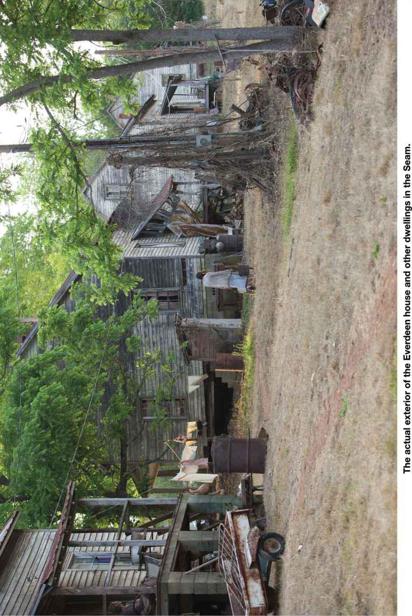
It appealed to Gary Ross because, as he puts it, “It’s one thing to live in squalor, but it’s another thing to live in squalor without any individuality, where the houses are cookie-cutter and manufactured by the company, not the people.”
Messina’s team built an interior in one of the houses — for the Everdeen family — and added details to the others to make it appear as if people were living in them. The only problem, really, was that Messina had first seen the town in winter, months before the filming began. “Without leaves and brown grass, it looked the right sort of dismal,” he remembers. “As spring took hold, though, it started getting greener and more lush. It looked sort of like a golf course.” Before the cast arrived, the crew plucked leaves off trees and covered patches of grass so it would turn brown.
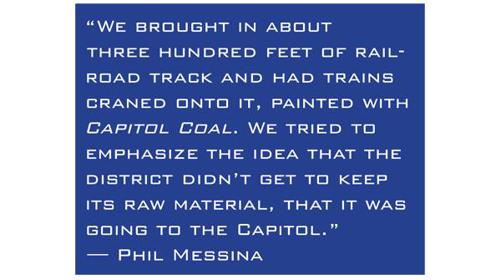
In Shelby, North Carolina, Messina’s location manager, Todd Christensen, found an old warehouse complex where the people of District 12 might gather for the reaping. “Phil wanted a big enough square to do our scenes, which meant we had to cut one of the buildings in half,” he remembers. “I had to negotiate that. And then the building was filled with junk, so we had to find the guy who owned it to get the junk out — so we could cut the building in half. It’s one of those things that people don’t know about that happens in order to make a look.”
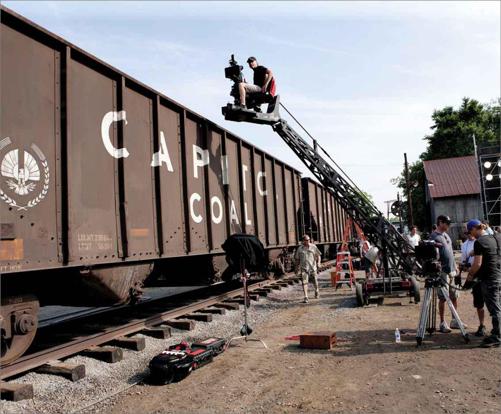
The crew sets up for a shot in District 12.
On one of the warehouse walls the team built a Hall of Justice, the Capitol’s headquarters in the district. And the Capitol’s shadow was also visible in the railroad cars Messina had painted with
Capitol Coal
and lowered onto the site with cranes. Just to emphasize, says Messina, “that the district’s raw material was not going to them — it was going to the Capitol.”
Near Charlotte, a former Philip Morris plant was sitting empty. Todd Christensen says, “When I got here in February they were toward the end of cutting up every piece of machinery for scrap and they had cleared out this building in order to sell it.” It was a two-thousand-acre campus, with three million square feet of manufacturing and office space.
Messina and Ross had talked about building a Training Center for the tributes, but because it was in the Capitol it would have to be enormous. “I suggested to Gary that he come and look at this Philip Morris plant because there were some huge spaces.” It had high ceilings, no pillars, and just the scale the production needed. Rather than build a Training Center from scratch, the team decided to construct one within the plant. There was plenty of room to create multiple training stations for the tributes, as well as a balcony for the Gamemakers.
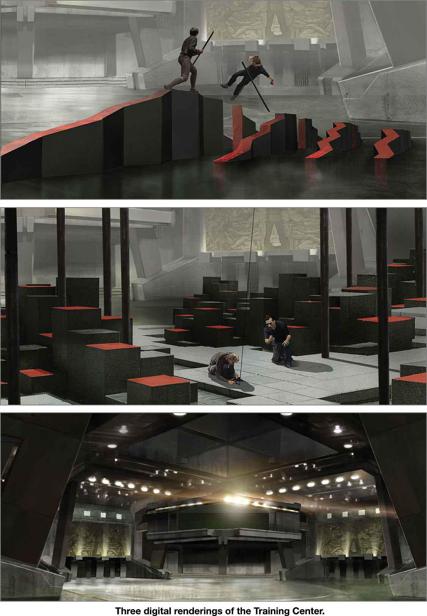
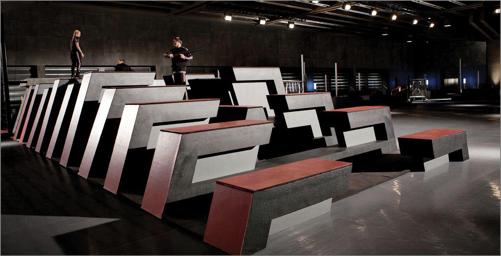
The tributes run through the gauntlet in the Training Center.
Even the woods locations required a great deal of advance planning. Messina scouted in various state parks in January and February. “I was scouting in the snow, with no leaves on any of the trees. I’m referring back to books about what this place looks like in the summertime and there’s a little bit of a leap of faith, but ultimately it worked out well.”
Ross adds, “The arena’s obviously in the forest and I wanted it to be different from a lot of forests you see in movies. I wanted it to have hardwoods — I didn’t want it to be just coniferous. I wanted it to feel uniquely American.”
Eventually they used the same woods for District 12 and the arena, but postproduction work changed the lighting and the feel of the arena setting, so the woods didn’t look quite natural, but more like a creation of the Gamemakers. As Messina describes it, “We just took out a little bit of the haphazardness of nature.”
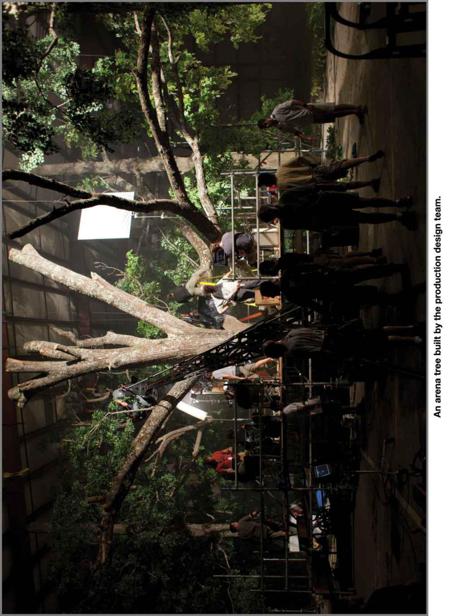

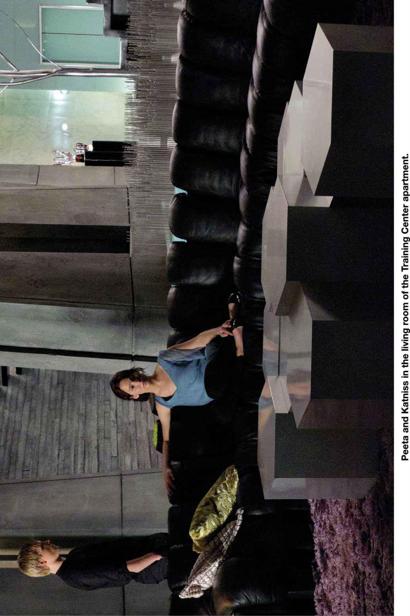
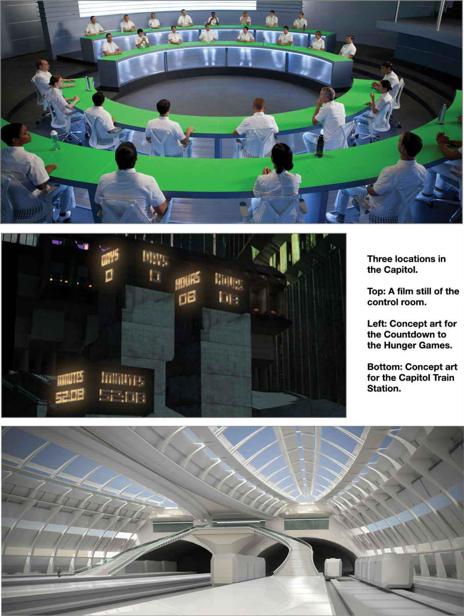
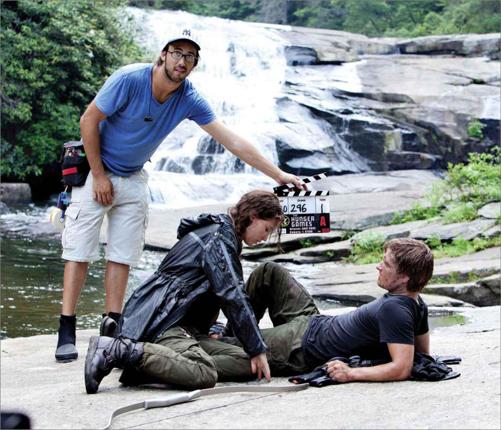
Lawrence and Hutcherson begin a scene in the arena.
Creating the Cornucopia was a special challenge to the design team. “In the book it says that it’s a cornucopia like the one that’s used at holiday time,” says director Gary Ross. “But we paused and wondered: What does that mean in the future? I wanted to create a large metallic sculptural element that almost seemed like a knife-edge into the natural world. We came up with this faceted, sculptural object that felt evocative of the Capitol: hard and cold.”
Messina explains, “We looked at some of Frank Gehry’s work such as Disney Hall and we looked at a lot of modern architecture that’s taking place right now, with sort of folded planes. I think Suzanne described it as being painted gold, but we ended up going with a gunmetal gray. It’s actually one of my favorite pieces in the movie. We built it in Charlotte and trucked it out to Asheville, set it out with a crane on location.”
